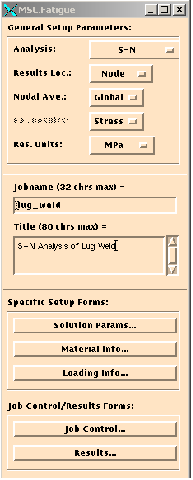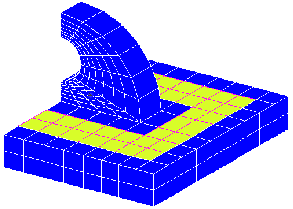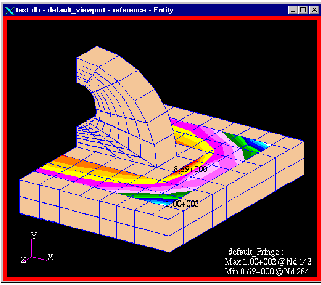XXXXXXXXXXXXXXXXXXXXXXXXXXXXXXXXXXXXXXXXXXXXXXXXXXXXXXXXXXXXXXXXXXXXXXXXXXXXXXXXXXXXXXXXXXXXXXXXXXXXXXXXXXXXXXXXXXXXXXXXXXXXXXXXXXXXXXXXXXXXXXXXXXXXXXXX''"> S-N Analysis of Lug Weld
Due to symmetry, only one half of the lug assembly was modeled. Open the MSC Fatigue setup form and set the General Setup Parameters as follows:
1. Analysis: S-N
2. Results Loc.: Node
3. Nodal Ave.: Global
4. F.E. Results: Stress
5. Res. Units: MPa
6. Jobname: lug_weld
7. Title: S-N Analysis of Lug Weld
Solution Parameters
Open the Solutions Params... form and set the widgets as follows leaving the defaults if not mentioned:
1. Mean Stress Correction: None
2. Design Criterion: 96
Set the design criterion at 96% certainty of survival.
3. Run Factor of Safety Analysis: ON
Turn this toggle ON. More will be explained about this analysis later.
4. Options: Life Based
5. Enter a Design Life: 100
This will correspond to 100 years of operation as will be designated when the service loading is defined.
Material Information
Since the assembly has a welded connection, it is appropriate to assess the life of this feature using the Total Life approach since the weld material properties are unknown.
Enter the materials database manager PFMAT either from the MSC Fatigue forms or directly from the system prompt by typing pfmat. One of the selections in PFMAT is a Weld Classifier. See if you can determine which type of weld you are dealing with by answering the questions from the weld classifier.
Hint: | The assembly has a welded detail on the surface of a member with potential cracks initiating at short weld attachments. The weld toe is more than 10 mm from the member edge. The shear stress is less than half the applied direct stress. |
The weld classifier should identify the weld as Class F type 2.9 if all the inputs are correct. You will refer to this weld class in the Material Info... form. Exit PFMAT.
Open the Material Info... form and fill out the spreadsheet for a single material as follows:
1. Material: classF
2. Finish: No Finish
3. Treatment: No Treatment
4. Region: reference
The Group called reference does not yet exist so you will need to create it. The classF entry is a component S-N curve. If you remember back to the discussion about component S-N curves you will recall that they are representative of the component’s geometry (the weld in this case) and the measured nominal stress is from a reference location away from the weld failure itself (such as where a strain gauge could be properly located).
For the sake of this example, let us assume that we know only approximately where this reference location is and only within a certain tolerance. Select all the nodes on the surface one element thickness away from the weld on the flat plate and two elements thick. The analysis will assume that each of these nodes is the reference location respectively and we will make the determination of the worst case later. Call the new group reference.
Note: | In this particular case the reference location for this Class F component S-N curve corresponds to Node 284 on the model. This node is in the area away from the stress concentration but reasonable for definition of Class F weld. |
Loading Information
Open the Loading Info... form and select the Time History Manager button. The load history, to be called LUGLOAD, consists of a single cycle with a min = 0 and max = 10. (The actual load applied is ten times greater than that applied in the FE model.) The units are Force in Newtons. The service load simulates the lug being lifted which happens two times a day. The fatigue equivalent unit should be Years with one repeat of the time history simulating 1/(2lifts*365days) = 0.00137 years. Enter this information into PTIME using Enter X-Y points where the y values are 0,10,0. To reiterate the details:
1. Filename: LUGLOAD
2. Description 1: Lug Loading
3. Description 2: whatever you want
4. Load type: Force
5. Units: Newtons
6. Number of fatigue equivalent units: 0.00137
7. Fatigue equivalent units: Years
On the Loading Info... form, associate the time variation of the load that you just created to the FE load case by filling out the spreadsheet.
1. Load Case ID: 1.1-3.1-1-
Select the only result case available, Default, Static Subcase and Stress Tensor, NON-LAYERED.
2. Time History: LUGLOAD
3. Load Magnitude: 1.0
Job Control
Open the Job Control... form and set the Action to Full Analysis and click the Apply button to run the job. Monitor the job form time to time. Since you have requested to do a Factor of Safety analysis, when you see the message
Safety factor analysis completed successfully.
the job is complete.
Results - Factor of Safety Analysis
For the Factor of Safety Analysis, the options are None, stress based, and life based.
Stress-based analyses are relevant to S-N analysis and apply to a class of structures where fatigue lives are essentially infinite. In the simplest sense, in order to assess the fatigue life of this class of structures, it is useful to obtain a measure of the margin between the working (applied stress) and the fatigue endurance stress (the limit below which no fatigue damage is incurred). The ratio of the endurance stress/working stress is known as the factor of safety. This is ideal for hand calculations using idealized loadings but for realistic variable amplitude loading, a more rigorous approach is used (see the MSC Fatigue User’s Guide for the equations used) that estimates the overdesign or underdesign factor on the user-supplied reference stress. Factors close to unity indicate the design has been achieved, factors less than unity indicate underdesign and factors greater than unity indicate overdesign.
The Life based calculation is an iterative calculation used to find the magnitude of the scaling factor on the stress-time spectrum that will cause failure for a specified design life. The scaling factor is applied to all cycles and is, thus, an overall factor of safety far better suited for random loading.
To begin the analysis, open the Results... form and with the Action set to Read Results, click the Apply button to read the analysis results into the database. Next set the Action to List Results and invoke PFPOST, the tabular listing module. If you request to list the Most damaged nodes you will see that there are no damaged nodes. Therefore, for the weld, we have satisfied the design goal of 100 years of service and, in fact, have designed a fail-safe structure.
If you desire, assume that the weld is the worst class, which is Class W. Rerun the analysis using this new S-N data set. You should see that there are still no damaging nodes and therefore, the weld does not fail.
Infinite life does not tell us much though. For this reason we ran the Factor of Safety analysis. Open the Results... form from the main form to make a contour plot of Safety Factor using the Factor of Safety result case. Note that the smallest safety factor (at Node 284) is around 8 1/2 times.
When you expect a component to survive a very large number of significant loading cycles, e.g., around 108 cycles or more, it is not reasonable to make finite life predictions; you are too near to the fatigue limit where the amount of scatter is very large. For cases like this it makes more sense to apply a Factor of Safety method which aims to put the design below the fatigue limit by a selected safety margin. Two methods can be used.
In general, the Stress-Based method compares the largest stress cycle that occurs in the loading sequence to a Reference Stress (normally the fatigue limit) taking into account the mean stress.
The Life-Based method requires the target Design Life, the usage of a Material Cutoff value, and a Maximum Factor (default is 100) to be set. The Maximum Factor is simply used to stop the analysis for any particular location when this maximum is reached and go on to the next location. This can speed up the analysis if lowered significantly.
The Material Cut-off is like the fatigue limit. It is the point beyond which damage will not be considered. If you are carrying out a life-based safety factor calculation, it is clear that if you change the cutoff you will reduce the influence of small cycles and hence get a larger safety factor. If you are doing a crack initiation based safety factor, changing the cutoff may also change the slope of the strain-life curve if you are using a surface finish or treatment correction. This is because the surface factors are applied at the cutoff.
For life-based calculations, the method is iterative. The calculation stops when the life is within a certain percentage of the target life - 5% by default. If you increase the allowable error, the number of iterations is reduced. This can only be changed by running FEFAT interactively.
Note: | In an earlier exercise we stated that making a contour plot of life (or safety factor in this case) from a component S-N analysis is meaningless and only the result at the reference location has any meaning. This is true, except in the case where you are not quite sure where that location is and wish to weigh the relative importance between different locations. Really only Node 284 has the correct safety factor but you can tell the relative magnitude difference if some other node were the actual reference location. With this simple loading, it is obvious that all other nodes will be less than Node 284 but with more complicated loading situations, this quickly becomes unclear. |
Hint: | PFPOST can also tabulate safety factor results. When you invoke PFPOST, type the .fos extension onto the jobname. This way it will pick up the jobname.fos result file created by a Factor of Safety analysis instead of the default jobname.fef file from regular life analysis. |



